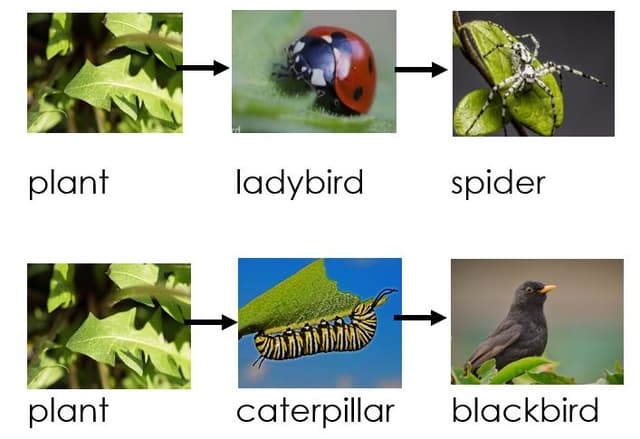Myths about teaching can hold you back
- Year 4
Comparing different food chains
I can create my own food chains and use scientific language to compare them with others.
- Year 4
Comparing different food chains
I can create my own food chains and use scientific language to compare them with others.
These resources were made for remote use during the pandemic, not classroom teaching.
Switch to our new teaching resources now - designed by teachers and leading subject experts, and tested in classrooms.
Lesson details
Key learning points
- A food chain includes a producer and consumers, including predators and prey.
- Food chains can be compared by looking at what is similar and what is different.
- A plant or animal can be part of many different food chains.
- People who work with and study animals can be used as secondary sources of information about what animals eat.
Keywords
Food chain - A food chain shows how living things depend on each other for food.
Predator - A predator is an animal that hunts, kills and eats other animals.
Prey - An animal that is hunted and eaten by another animal is called prey.
Compare - We compare things by looking at what is the same and what is different.
Secondary source - Secondary sources are texts, images or objects created using information gathered by others.
Common misconception
Children may think that a plant or animal can only be part of one food chain.
This lesson shows a number of examples of how plants and animals can be part of many different food chains. Children are encouraged to research and create different food chains for the same plant or animal.
To help you plan your year 4 science lesson on: Comparing different food chains, download all teaching resources for free and adapt to suit your pupils' needs...
To help you plan your year 4 science lesson on: Comparing different food chains, download all teaching resources for free and adapt to suit your pupils' needs.
The starter quiz will activate and check your pupils' prior knowledge, with versions available both with and without answers in PDF format.
We use learning cycles to break down learning into key concepts or ideas linked to the learning outcome. Each learning cycle features explanations with checks for understanding and practice tasks with feedback. All of this is found in our slide decks, ready for you to download and edit. The practice tasks are also available as printable worksheets and some lessons have additional materials with extra material you might need for teaching the lesson.
The assessment exit quiz will test your pupils' understanding of the key learning points.
Our video is a tool for planning, showing how other teachers might teach the lesson, offering helpful tips, modelled explanations and inspiration for your own delivery in the classroom. Plus, you can set it as homework or revision for pupils and keep their learning on track by sharing an online pupil version of this lesson.
Explore more key stage 2 science lessons from the More about food chains unit, dive into the full primary science curriculum, or learn more about lesson planning.

Equipment
Access to secondary sources such as books and the internet. An opportunity to video call someone who works with animals, or arrange a visit or visitor in school would enrich this lesson further.
Content guidance
- Exploration of objects
- Depiction or discussion of violence or suffering
Supervision
Adult supervision required
Licence
Prior knowledge starter quiz
6 Questions
Q1.What do we do when we compare objects?
Q2.What does it mean to look for similarities between objects?
Q3.What does it mean to carry out research?
Q4.True or false? The plants in a food chain are producers.
Q5.True or false? Some producers in a food chain can also be predators.
Q6.Which statement about predators and prey is correct?
Assessment exit quiz
6 Questions
Q1.We can food chains by looking at what is similar and what is different.
Q2.Compare these food chains. What is the same about them?

Q3.Compare these food chains. What is different about them?



